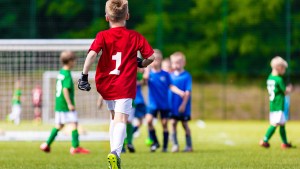Well, this is terrifying: The Washington Post just reported a study in Preventative Medicine which found that American children are alarmingly inactive:
Vijay Varma, a National Institute on Aging researcher and lead author of the study, said that there has been a belief that physical activity gradually declines across the entire life span. But according to the new data, there seems to be a sharper-than-expected decline during childhood — starting in elementary school and continuing through middle school and high school. By age 19, the average American is as sedentary as a 60-year-old.
Did you get that? Today’s 19-year-olds have the same level of physical activity as a 60-year-old.
That’s insane! 19-year-olds should be at their physical peak, not bottoming out. The study’s authors theorized that, as expected, the abundance of screens is having a detrimental effect on adolescent physical activity–but surprisingly, they pointed to an even greater culprit: school.
The data showed that school-aged kids were most active after school hours, which makes sense. But even then, their activity might be lower than it should be due to sleep deprivation. According to researchers, early school start times are inconsistent with children’s natural biology (as is the entire institution of sitting for 8 hours a day).

Read more:
Raising teens is not a lot different than raising toddlers
The good news is that the study found physical activity increasing for people in their 20s, a phenomenon Varma calls the “catch-up period.” And while making up for years of sedentary living is certainly good, there’s no doubt it would be better if kids were getting the right amount of physical activity in the first place.
It would be great if school administrators and teachers could get together with parents and create a school day that actually works with the natural rhythms of a child’s biology, rather than against them. But until then, it’s on us parents to encourage our kids to move in whatever way motivates them the most.
This is fairly easy with younger kids, who are happy to run around and yell for no reason at all. But teenagers can be notoriously resistant to physical exercise, especially if they aren’t passionate about a particular sport. So you might have to get creative.

Read more:
Can sports bring your child closer to God?
When we were teenagers, my dad used to take us to a playground late at night to play flashlight tag–essentially hide-and-seek in the dark. He’d always pick a playground without many streetlights nearby so it was truly pitch-black, and the combination of fear, adrenaline, and exhilaration made this a ridiculously good workout and one of my favorite teenage memories.
Our youth group also had regular broomball nights, for which they rented out an ice rink from midnight to 2 a.m. I was hideously uncoordinated, but I still ran around on the ice and got sweaty and had fun, because it was low-pressure and more about socialization than athletic excellence.
If you’ve got a teenager who’s resistant to exercise, try to make it fun. Encourage them to join roller derby or offer to join them for a zombie fun run, but keep the stakes low. Don’t pressure or nag–try to show them that physical activity is fun. Eventually, they’ll come to believe you.

